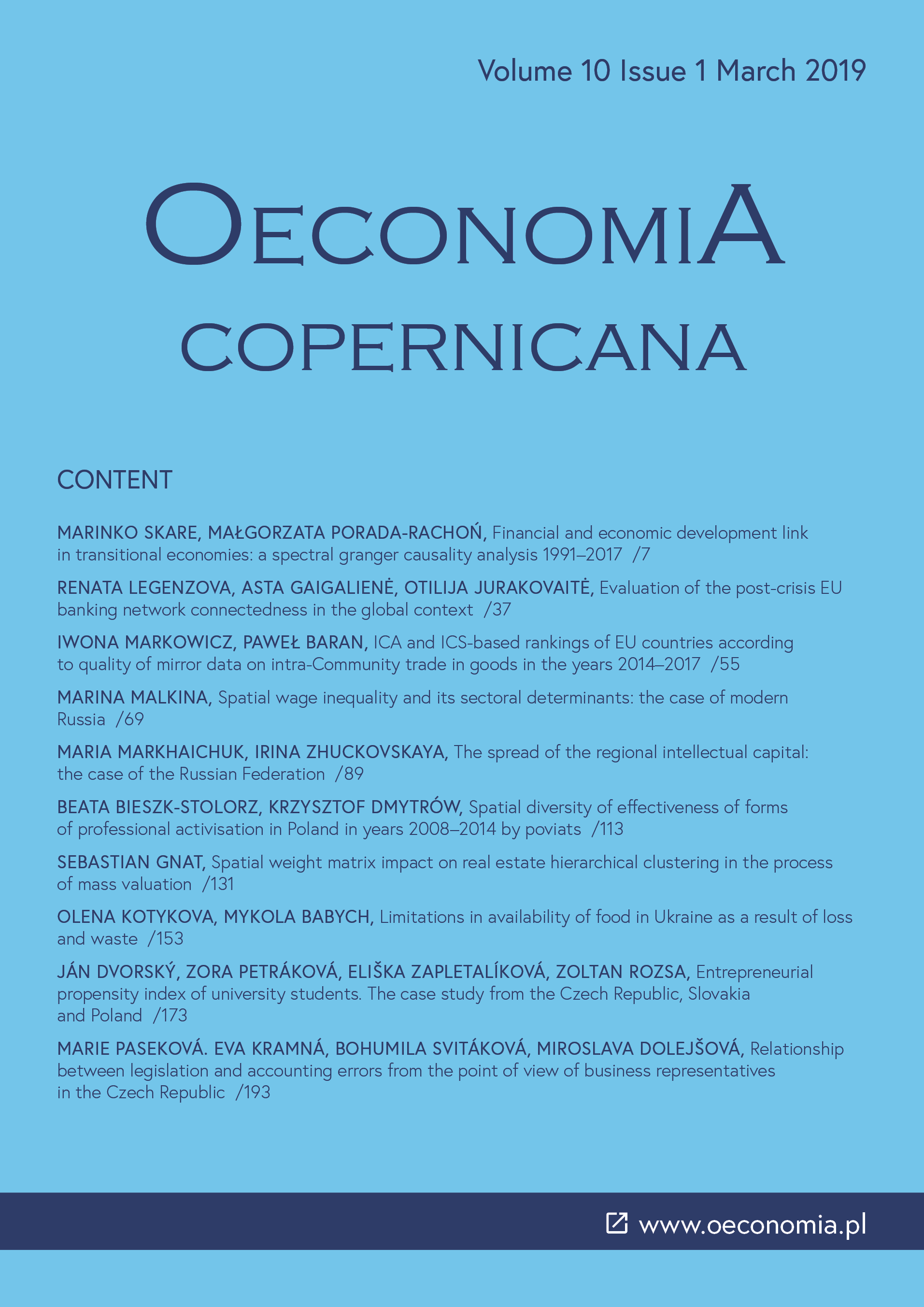ICA and ICS-based rankings of EU countries according to quality of mirror data on intra-Community trade in goods in the years 2014?2017
DOI:
https://doi.org/10.24136/oc.2019.003Keywords:
official statistics data quality, mirror data, intra-Community trade, EUAbstract
Research background: As a system of official EU statistics, Intrastat contains data collected by Member States aggregated by Eurostat on the Union?s level in the form of COMEXT database. Country-level data are based on declarations made by businesses dispatching or acquiring goods from other EU Member States. Since the same transaction is declared twice ? as an ICS in one country and at the same time as an ICA in another country by the partner ? the database contains mirror data. Analysis of mirror data lets us assess the quality of public statistics data on international trade.
Purpose of the article: The aim of the article is to rank EU Member States according to quality of data on intra-Community trade in goods collected by Intrastat. Foreign trade stimulates economic development on one hand and is the development?s reflection on the other. Thus it is very important that official statistics in this area be of good quality. Analysis of mirror data from partner states in intra-Community trade in goods allows us to claim that not every Member State pro-vides data of satisfactory quality level.
Methods: We used the authors? methodology of assessing quality of mirror data. These include data asymmetry indices, both proposed by Eurostat and the authors? own proposals. We have also examined the changes in the above mentioned rankings over time.
Findings & Value added: The result of the survey is ordering of EU Member States according to the quality of data on intra-Community trade in goods. The rankings are presented for the period of 2014?2017, during which there were 28 Member States of the EU. Changes in distinct countries? positions were shown as a result of changes in overall quality of statistical data collected in these countries. The research methodology can be used in the process of monitoring data quality of the Intrastat system.
Downloads
References
Baran, P., & Markowicz, I. (2018a). Analysis of intra-community supply of goods shipped from Poland. Socio-Economic Modelling and Forecasting, 1.
View in Google Scholar
Baran, P., & Markowicz, I. (2018b). Behavioral economics and rationality of certain economic activities. The case of intra-community supplies. In K. Nermend & M. Łatuszyńska (Eds.). Problems, methods and tools in experimental and behavioral economics. Cham: Springer.
DOI: https://doi.org/10.1007/978-3-319-99187-0_21
View in Google Scholar
Brodzicki, T., Śledziewska, K., Ciołek, D., & Umiński, S. (2015). Extended gravity model of Polish trade. Empirical analysis with panel data methods. Working Paper. Institute for Development, 003.
View in Google Scholar
Eurostat (2017a). Compilers guide on European statistics on international trade in goods, 2017 edition. Manuals and guidelines. Luxembourg: Publications Office of the European Union. Retrieved from http://ec.europa.eu/eurostat (15.08.2018).
View in Google Scholar
Eurostat (2017b). National requirements for the Intrastat system. 2018 edition. Luxembourg: Publications Office of the European Union. Retrieved from http://ec.europa.eu/eurostat (3.11.2018).
View in Google Scholar
Ferrantino, M. J., Liu, X., & Wang, Z. (2012). Evasion behaviors of exporters and importers: evidence from the U.S.–China trade data discrepancy. Journal of International Economics, 86(1). doi: 10.1016/j.jinteco.2011.08.006.
DOI: https://doi.org/10.1016/j.jinteco.2011.08.006
View in Google Scholar
Ferrantino, M. J., & Wang, Z. (2008). Accounting for discrepancies in bilateral trade: the case of China, Hong Kong, and the United States. China Economic Review, 19(3). doi: 10.1016/j.chieco.2008.02.002.
DOI: https://doi.org/10.1016/j.chieco.2008.02.002
View in Google Scholar
Hamanaka, S. (2012). Whose trade statistics are correct? Multiple mirror comparison techniques: a test of Cambodia. Journal of Economic Policy Reform, 15(1). doi: 10.1080/17487870.2012.657827.
DOI: https://doi.org/10.1080/17487870.2012.657827
View in Google Scholar
Javorsek, M. (2016). Asymmetries in international merchandise trade statistics. UN ESCAP Statistics Division Working Paper, 02.
View in Google Scholar
Markowicz, I., & Baran, P. (2019). Quality of trade in goods between European Union Member States. Wiadomości Statystyczne, 1(692).
DOI: https://doi.org/10.5604/01.3001.0013.8531
View in Google Scholar
Parniczky, G. (1980). On the inconsistency of world trade statistics. International Statistical Review, 48(1). doi: 10.2307/1402404.
DOI: https://doi.org/10.2307/1402404
View in Google Scholar
Simon, H. A. (1972). Theories of bounded rationality. In C. B. McGuire & R. Radner (Eds.). Decision and organization. Amsterdam: North Holland Pub. Co.
View in Google Scholar
ten Cate, A. (2014). The identification of reporting accuracies from mirror data. Jahrbücher für Nationalökonomie und Statistik, 234(1). doi: 10.1515/jbnst-2014-0106.
DOI: https://doi.org/10.1515/jbnst-2014-0106
View in Google Scholar
Tsigas, M. E., Hertel, T. W., & Binkley, J. K. (1992). Estimates of systematic reporting biases in trade statistics. Economic Systems Research, 4(4). doi: 10.1080/09535319200000028.
DOI: https://doi.org/10.1080/09535319200000028
View in Google Scholar






